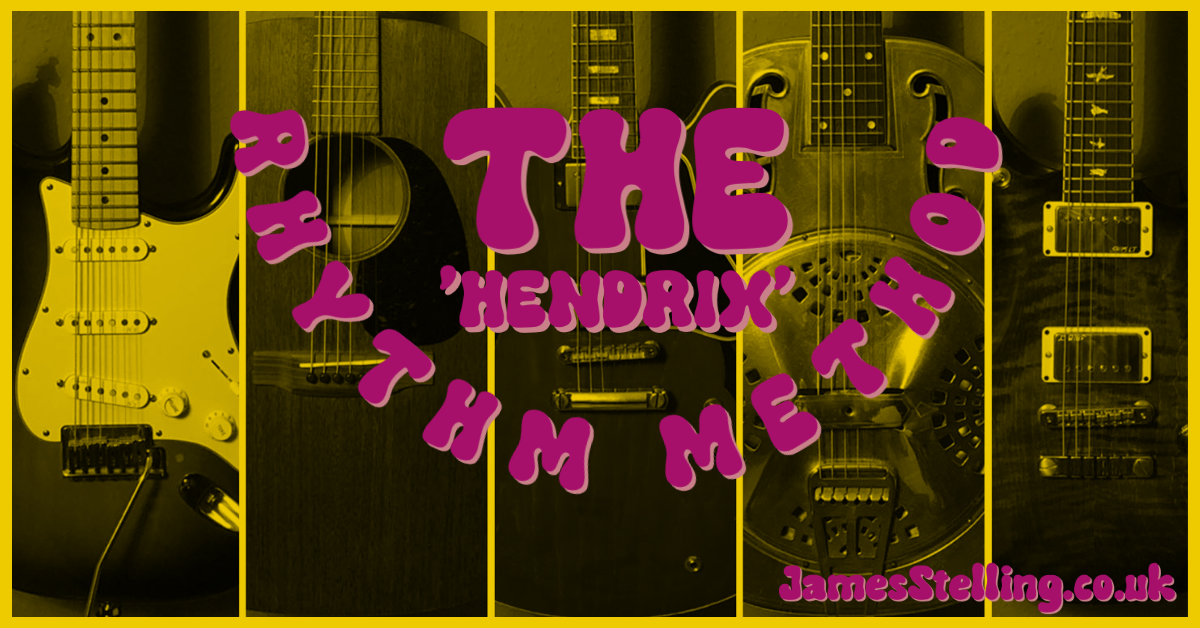The following is a study of (and a lesson in) the rhythm guitar style of Jimi Hendrix using video, audio examples, written music, Tab and backing tracks.
The above video is an example of the sort of rhythm guitar style popularised by Jimi Hendrix in songs such as 'The Wind Cries Mary' or 'Little Wing'.
A lot of my students often ask about how to learn this style of rhythm guitar as they can become quite confused as to what Hendrix was actually doing to illicit the effect of playing both chords and lead playing at the same time.
The answer lies in double stops, triads and pentatonic embellishments.
In other words Hendrix was often playing two notes (a double stop) from the chord of the moment (E for example) and adding a note or notes from the pentatonic scale related to the chord of the moment (E major pentatonic in this case) to create a mild tension and most often resolving back to the chord of the moment or moving on to the next chord.
In this lesson I've presented you with 10 such examples of this approach culminating in a study where these examples are collated and played over a Hendrix-esque chord progression.
Each lick has an audio example and a slowed down audio example for your reference in addition to the written music.
There is also a backing track and a slowed down backing track for you to practise both the licks and finally the study to.
It is important to see the chord and the pentatonic scale that you are using when learning these examples so I have provided chord/scale diagrams for each of the 3 positions that I have used to derive these licks from.
In these scale diagrams the white circles are the root notes, the white squares are the chord tones (3rds and 5ths) and the black circles are the pentatonic notes (2nds and 6ths).
All of these examples are for an E major chord. When you want to use these over a minor chord you just find that minor chord's relative major. So if you wanted to play over C# minor you would use these E major ideas. I f you wanted to play over Am you would transpose these ideas into C major. If this is confusing try reading up on relative minor/majors. I'd also recommend checking out my new book Music Theory for Guitar.
These first 3 licks come from Position 5 of the Major Pentatonic Scale. You can see this shape as being from the typical G open chord shape that you will all be familiar with (see the white notes).
Position 5
Here is a backing track to practise each lick with.
Here is the same backing track at 70% speed.
Lick 1
Lick 2
Lick 3
These next 4 licks come from Position 1 of the Major Pentatonic Scale. You can see this shape as being from the typical E open chord shape that you will all be familiar with.
Position 1
Lick 4
Lick 5
Lick 6
Lick 7
These last 3 licks come from Position 3 of the Major Pentatonic Scale. You can see this shape as being from the typical C open chord shape that you will all be familiar with.
Position 3
Lick 8
Lick 9
Lick 10
The following study uses only licks learned so far from this lesson. These ideas have been transposed to the appropriate chord and over the C#m7 I have used E major ideas as E is the relative major of C#m.
Example Study
This is the solo that we will be learning.
This is the same solo at 50% speed to practise to.
Here is a backing track for you to practise with.
Here is the same backing track at 70% speed.
I hope you've enjoyed this lesson and found it helpful.
Please check back regularly for more and if you're enjoying them & finding them useful then please consider donating (no matter how little) as a means of support.
You could also consider buying my comprehensive yet very reasonably priced books on the CAGED System or Music Theory for Guitar via these links or in my Store at the top of this page where you can also read previews of both books.
Thanks so much, James.
























